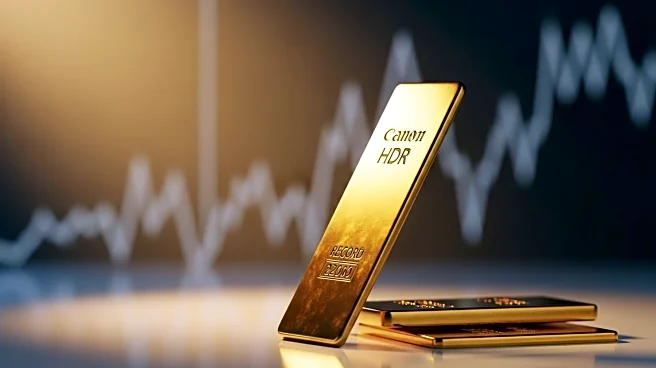What's Happening?
Gold prices have reached a new record high, driven by escalating trade tensions between the United States and China, alongside expectations of interest rate cuts. Spot gold increased by 0.7% to $4,235.41 per ounce, marking a fifth consecutive session
of gains. U.S. gold futures for December delivery also rose by 1.2% to $4,252.30. The surge in gold prices, which have risen 61% year-to-date, is attributed to investors seeking safe-haven assets amidst global economic instability. The trade spat has intensified with U.S. officials criticizing China's expansion of rare earth export controls, which threatens global supply chains. Additionally, the ongoing federal government shutdown in the U.S. is contributing to economic uncertainty, potentially costing the economy $15 billion a week in lost production.
Why It's Important?
The rise in gold prices highlights the growing investor anxiety over U.S.-China trade relations and the broader economic implications. As gold is traditionally seen as a store of value during times of instability, its increased demand reflects concerns over U.S. policy credibility and the potential impact of trade frictions on global supply chains. The anticipation of interest rate cuts by the U.S. Federal Reserve further boosts gold's appeal, as non-yielding assets typically perform well in low interest-rate environments. This development could influence investment strategies, with more investors turning to gold as a hedge against economic volatility.
What's Next?
The trajectory of gold prices will likely depend on the continuation of trade tensions and monetary policy decisions. Traders are currently pricing in a 25 basis-point cut by the U.S. Fed in October, with another expected in December. If these rate cuts materialize, they could further support gold's upward momentum. Additionally, the resolution of the federal government shutdown and any changes in U.S.-China trade negotiations will be closely monitored by investors, as these factors could significantly impact market dynamics.
Beyond the Headlines
The ongoing trade tensions and economic uncertainty may lead to long-term shifts in investment strategies, with a potential increase in allocations to gold and other safe-haven assets. This trend could also influence central bank policies and global financial markets, as countries reassess their economic strategies in response to geopolitical developments.













